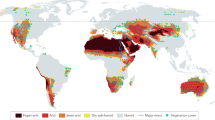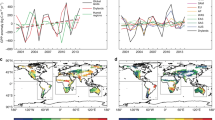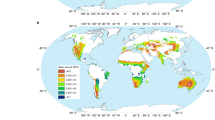Abstract
Drylands, comprising land regions characterized by water-limited, sparse vegetation, have commonly been projected to expand globally under climate warming. Such projections, however, rely on an atmospheric proxy for drylands, the aridity index, which has recently been shown to yield qualitatively incorrect projections of various components of the terrestrial water cycle. Here, we use an alternative index of drylands, based directly on relevant ecohydrological variables, and compare projections of both indices in Coupled Model Intercomparison Project Phase 5 climate models as well as Dynamic Global Vegetation Models. The aridity index overestimates simulated ecohydrological index changes. This divergence reflects different index sensitivities to hydroclimate change and opposite responses to the physiological effect on vegetation of increasing atmospheric CO2. Atmospheric aridity is thus not an accurate proxy of the future extent of drylands. Despite greater uncertainties than in atmospheric projections, climate model ecohydrological projections indicate no global drylands expansion under greenhouse warming, contrary to previous claims based on atmospheric aridity.
This is a preview of subscription content, access via your institution
Access options
Access Nature and 54 other Nature Portfolio journals
Get Nature+, our best-value online-access subscription
$29.99 / 30 days
cancel any time
Subscribe to this journal
Receive 12 print issues and online access
$209.00 per year
only $17.42 per issue
Buy this article
- Purchase on Springer Link
- Instant access to full article PDF
Prices may be subject to local taxes which are calculated during checkout






Similar content being viewed by others
Data availability
All climate model simulations used in the Article are from CMIP5 and are publicly available—for instance, at https://esgf-node.llnl.gov/search/cmip5/. All ISIMIP simulations are freely available as well—for example, at https://esg.pik-potsdam.de/search/isimip/. All calculated data generated from these sources are available from the corresponding author upon request.
Code availability
The custom R code written to read and analyse the data and generate the figures is available on GitHub at https://doi.org/10.5281/zenodo.4490414 (ref. 51).
References
D’Odorico, P. & Porporato, A. Dryland Ecohydrology (Springer, 2019).
Smith, W. K. et al. Remote sensing of dryland ecosystem structure and function: progress, challenges, and opportunities. Remote Sens. Environ. 233, 111401 (2019).
Reynolds, J. F. et al. Global desertification: building a science for dryland development. Science 316, 847–851 (2007).
Ahlström, A. et al. The dominant role of semi-arid ecosystems in the trend and variability of the land CO2 sink. Science 348, 895–899 (2015).
Middleton, N. & Thomas, D. S. G. World Atlas of Desertification 2nd edn (Wiley, 1997).
Budyko, M. I. & Miller, D. H. International Geophysics Series: Climate and Life Vol. 18 (Academic Press, 1974).
Feng, S. & Fu, Q. Expansion of global drylands under a warming climate. Atmos. Chem. Phys. 13, 10081–10094 (2013).
Fu, Q. & Feng, S. Responses of terrestrial aridity to global warming. J. Geophys. Res. Atmos. 119, 7863–7875 (2014).
Scheff, J. & Frierson, D. M. W. Terrestrial aridity and its response to greenhouse warming across CMIP5 climate models. J. Clim. 28, 5583–5600 (2015).
Huang, J., Yu, H., Guan, X., Wang, G. & Guo, R. Accelerated dryland expansion under climate change. Nat. Clim. Change 6, 166–171 (2016).
Huang, J., Yu, H., Dai, A., Wei, Y. & Kang, L. Drylands face potential threat under 2 °C global warming target. Nat. Clim. Change 7, 417–422 (2017).
Park, C.-E. et al. Keeping global warming within 1.5 °C constrains emergence of aridification. Nat. Clim. Change 8, 70–74 (2018).
Koutroulis, A. G. Dryland changes under different levels of global warming. Sci. Total Environ. 655, 482–511 (2019).
Park, C. E. et al. Inequal responses of drylands to radiative forcing geoengineering methods. Geophys. Res. Lett. 46, 14011–14020 (2019).
Wei, Y. et al. Drylands climate response to transient and stabilized 2 °C and 1.5 °C global warming targets. Clim. Dyn. 53, 2375–2389 (2019).
Yao, J. et al. Accelerated dryland expansion regulates future variability in dryland gross primary production. Nat. Commun. 11, 1665 (2020).
Berdugo, M. et al. Global ecosystem thresholds driven by aridity. Science 367, 787–790 (2020).
Rajaud, A. & de Noblet-Ducoudré, N. Tropical semi-arid regions expanding over temperate latitudes under climate change. Climatic Change 144, 703–719 (2017).
Yang, Y. et al. Disconnection between trends of atmospheric drying and continental runoff. Water Resour. Res. 54, 4700–4713 (2018).
Greve, P., Roderick, M. L., Ukkola, A. M. & Wada, Y. The aridity index under global warming. Environ. Res. Lett. 14, 124006 (2019).
Milly, P. C. D. & Dunne, K. A. Potential evapotranspiration and continental drying. Nat. Clim. Change 6, 946–949 (2016).
Yang, Y., Roderick, M. L., Zhang, S., McVicar, T. R. & Donohue, R. J. Hydrologic implications of vegetation response to elevated CO2 in climate projections. Nat. Clim. Change 9, 44–48 (2019).
Norby, R. J. & Zak, D. R. Ecological lessons from free-air CO2 enrichment (FACE) experiments. Annu. Rev. Ecol. Evol. Syst. 42, 181–203 (2011).
Berg, A. & Sheffield, J. Soil moisture–evapotranspiration coupling in CMIP5 models: relationship with simulated climate and projections. J. Clim. 31, 4865–4878 (2018).
Mahowald, N. et al. Projections of leaf area index in Earth system models. Earth Syst. Dyn. 7, 211–229 (2016).
Sherwood, S. & Fu, Q. A drier future? Science 343, 737–739 (2014).
Berg, A. et al. Land–atmosphere feedbacks amplify aridity increase over land under global warming. Nat. Clim. Change 6, 869–874 (2016).
Berg, A. & Sheffield, J. Climate change and drought: the soil moisture perspective. Curr. Clim. Change Rep. 4, 180–191 (2018).
Lavergne, A. et al. Observed and modelled historical trends in the water‐use efficiency of plants and ecosystems. Glob. Change Biol. 25, 2242–2257 (2019).
Friedlingstein, P. Carbon cycle feedbacks and future climate change. Phil. Trans. R. Soc. A 373, 20140421 (2015).
Swann, A. L., Hoffman, F. M., Koven, C. D. & Randerson, J. T. Plant responses to increasing CO2 reduce estimates of climate impacts on drought severity. Proc. Natl Acad. Sci. USA 113, 10019–10024 (2016).
Lemordant, L., Gentine, P., Swann, A. S., Cook, B. I. & Scheff, J. Critical impact of vegetation physiology on the continental hydrologic cycle in response to increasing CO2. Proc. Natl Acad. Sci. USA 115, 4093–4098 (2018).
Berg, A. & Sheffield, J. Evapotranspiration partitioning in CMIP5 models: uncertainties and future projections. J. Clim. 32, 2653–2671 (2019).
Cao, L., Bala, G., Caldeira, K., Nemani, R. & Ban-Weiss, G. Importance of carbon dioxide physiological forcing to future climate change. Proc. Natl Acad. Sci. USA 107, 9513–9518 (2010).
Skinner, C. B., Poulsen, C. J. & Mankin, J. S. Amplification of heat extremes by plant CO2 physiological forcing. Nat. Commun. 9, 1094 (2018).
Kooperman, G. J. et al. Forest response to rising CO2 drives zonally asymmetric rainfall change over tropical land. Nat. Clim. Change 8, 434–440 (2018).
Frieler, K. et al. Assessing the impacts of 1.5 °C global warming—simulation protocol of the Inter-sectoral Impact Model Intercomparison Project (ISIMIP2b). Geosci. Model Dev. 10, 4321–4345 (2017).
Zhu, Z. et al. Greening of the Earth and its drivers. Nat. Clim. Change 6, 791–795 (2016).
He, B., Wang, S., Guo, L. & Wu, X. Aridity change and its correlation with greening over drylands. Agric. For. Meteorol. 278, 107663 (2019).
Brandt, M. et al. Human population growth offsets climate-driven increase in woody vegetation in sub-Saharan Africa. Nat. Ecol. Evol. 1, 0081 (2017).
Burrell, A. L., Evans, J. P. & De Kauwe, M. G. Anthropogenic climate change has driven over 5 million km2 of drylands towards desertification. Nat. Commun. 11, 3853 (2020).
Berg, A., Sheffield, J. & Milly, P. C. D. Divergent surface and total soil moisture projections under global warming. Geophys. Res. Lett. 44, 236–244 (2017).
Mankin, J. S., Seager, R., Smerdon, J. E., Cook, B. I. & Williams, A. P. Mid-latitude freshwater availability reduced by projected vegetation responses to climate change. Nat. Geosci. 12, 983–988 (2019).
Liu, Y. et al. Field-experiment constraints on the enhancement of the terrestrial carbon sink by CO2 fertilization. Nat. Geosci. 12, 809–814 (2019).
Zeng, Z. et al. Responses of land evapotranspiration to Earth’s greening in CMIP5 Earth System Models. Environ. Res. Lett. 11, 104006 (2016).
Peñuelas, J. et al. Shifting from a fertilization-dominated to a warming-dominated period. Nat. Ecol. Evol. 1, 1438–1445 (2017).
Brodribb, T. J., Powers, J., Cochard, H. & Choat, B. Hanging by a thread? Forests and drought. Science 368, 261–266 (2020).
Scheff, J., Seager, R., Liu, H. & Coats, S. Are glacials dry? Consequences for paleoclimatology and for greenhouse warming. J. Clim. 30, 6593–6609 (2017).
Ault, T. R. On the essentials of drought in a changing climate. Science 368, 256–260 (2020).
Berg, A. & Sheffield, J. Historic and projected changes in coupling between soil moisture and evapotranspiration (ET) confounded by the role of different ET components. J. Geophys. Res. Atmos. 124, 5791–5806 (2019).
Berg, A. & McColl, K. R code for ‘No global drylands expansion under greenhouse warming’. Zenodo https://doi.org/10.5281/zenodo.4490414 (2021).
Acknowledgements
We thank the World Climate Research Programme’s Working Group on Coupled Modelling, which is responsible for CMIP, and we thank the climate modelling groups (listed in Supplementary Table 1 of this paper) for producing and making available their model output. For CMIP, the US Department of Energy’s Program for Climate Model Diagnosis and Intercomparison provides coordinating support and led the development of software infrastructure in partnership with the Global Organization for Earth System Science Portals. For their roles in producing, coordinating and making available the ISIMIP input data and impact model output, we thank the modelling groups, the ISIMIP sector coordinators and the ISIMIP cross-sectoral science team for the Biomes sectors. K.A.M. acknowledges funding from a Winokur Seed Grant in Environmental Sciences from the Harvard University Center for the Environment.
Author information
Authors and Affiliations
Contributions
A.B. and K.A.M. designed the study. A.B. conducted the analysis and wrote the manuscript. K.A.M. advised on the interpretation of the results and contributed to the manuscript preparation.
Corresponding author
Ethics declarations
Competing interests
The authors declare no competing interests.
Additional information
Peer review information Nature Climate Change thanks Peter Greve, Congbin Fu and the other, anonymous, reviewer(s) for their contribution to the peer review of this work.
Publisher’s note Springer Nature remains neutral with regard to jurisdictional claims in published maps and institutional affiliations.
Supplementary information
Supplementary Information
Supplementary Table 1, Discussions 1–3 and Figs. 1–14.
Rights and permissions
About this article
Cite this article
Berg, A., McColl, K.A. No projected global drylands expansion under greenhouse warming. Nat. Clim. Chang. 11, 331–337 (2021). https://doi.org/10.1038/s41558-021-01007-8
Received:
Accepted:
Published:
Issue Date:
DOI: https://doi.org/10.1038/s41558-021-01007-8
This article is cited by
-
Irrigation expansion has kept pace with the CO2 fertilization effect on vegetation growth in a typical arid region
Environmental Sciences Europe (2024)
-
Disentangling contributions to past and future trends in US surface soil moisture
Nature Water (2024)
-
Evidence and attribution of the enhanced land carbon sink
Nature Reviews Earth & Environment (2023)
-
Apparent surface conductance sensitivity to vapour pressure deficit in the absence of plants
Nature Water (2023)
-
Human disturbance is the major driver of vegetation changes in the Caatinga dry forest region
Scientific Reports (2023)



